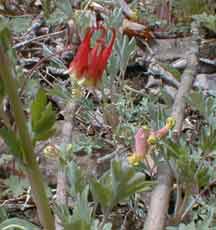





Bloodroot (Sanguinaria canadensis) displays large delicate flowers. Its leaves grasp its single flower stem. It is a Poppy family member. The sap is blood-red.





















Our Mission: The Mattabeseck Audubon Society, a chapter of the National Audubon
Society, is committed to environmental leadership and education for
the benefit of the community and the earth's biodiversity.
deKoven House,
27 Washington Street,
Middletown, Connecticut 06457
| A Walk in the Park | ||||||||||||
| Our mid-April hikes turn up a profusion of wildflowers in bloom. We never know what will be blooming when we schedule our trips in January, as temperatures and weather alter the timing of emergence. The best year so far—for the number of species in bloom at one time—was 2000. Here are a few of the highlights seen then, with many earlier-blooming and later-blooming plants added. | ||||||||||||
 |
 |
 |
||||||||||
| Round-lobed Hepatica (Hepatica americana), a member of the Buttercup family, thrives in hard ground. It's seen at Giufridda park in shades of blue, pink, and white. | Early Saxifrage (Saxifraga virginiensis) peeks up from under a lichen-covered rock. Find it in crevices in wet rocks within the path to the overlook. | Dutchman's Breeches (Dicentra cucullaria) is abundant on the steep slopes of broken talus rock. Its "pantaloons on a clothesline" flowers show it is a cousin to Bleeding Heart, both are members of the Poppy family. | ||||||||||
 |
 |
 |
||||||||||
Bloodroot (Sanguinaria canadensis) displays large delicate flowers. Its leaves grasp its single flower stem. It is a Poppy family member. The sap is blood-red. |
Bluets (Houstonia caerulea), every child's favorite flower, welcome Spring. They're members of the Bedstraw family. Flowers in sunny areas are bluer.. | Rattlesnake Plantain (Goodyera sp.), a member of the Orchid family, although not in bloom, displays lovely blue-green checkered leaves. | ||||||||||
 |
 |
 |
||||||||||
| Pussytoes (Antennaria neglecta) are well-named fuzzy spring flowers. They are member s of the Daisy family. Find them along the path in the wooded uplands. | Rue Anemone (Anemonella thalictroides), another member of the Buttercup family, shows its delicate white face among dried leaves. | Spicebush (Lindera benzoin) is in bloom in wet areas. Early colonists used its red fall berries as a spice to replace allspice. Leaves and twigs are unmistakeably citronella-scented. | ||||||||||
 |
 |
Northern Water Thrushes have been found near the stream on many field trips. And Pine Warblers are usually heard in the tops of the pines near the reservoir. | ||||||||||
| Red Trillium (Trillium sp.) is another member of the Lily family that is often found in shady woodlands. Flowers can be ±2" across. Look for these in the pine woods not far from the park entrance. | Great Trillium hid from us until 2011. The pale yellow blooom is even larger than its red counterpart. This species was found in the rocks just before the stream, above where the Blue Cohosh is found, but not seen since 2011. | |||||||||||
 |
 |
|||||||||||
| What are these lily-like leaves? Not a flower to be seen. That's because these are Ramps -- wild leeks. Get close enough to smell them and you'll know. The taller pleated leaves are Hellebore -- not to be eaten. | Downy Violets have fuzzy leaves that are more elongated than common violets. The flowers are very similar. | |||||||||||
 |
 |
|||||||||||
| Wood Anemone has 5-petaled white flowers and deep reddish-green leaves that are cut. The upper woods are sometimes blanketed with these. | The first butterfly of late winter / early spring is the Mourning Cloak (here feeding on tree sap). Body and wings are velvety deep red. Wings are trimmed with blue spots and a ruffledgold band. | |||||||||||
 |
 |
|||||||||||
| Red Columbine and Pale Corydalis bloom together on top of the trap rock ridge. In some patches these were joined by the more rare Yellow Corydalis. | Yellow Corydalis is a species of special concern that grows only in a few locations on the top of trap-rock ridges. Some years it is still dormant at Walk time. | |||||||||||
 |
 |
|||||||||||
| Wild Ginger hides its brown flower under its broad fuzzy leaves. Colonists used the roots to flavor baked goods, although they are not as robust as culinary Chinese ginger. | Spring Beautyhas delicately striped petals. It can be found near the stream in the park. (Its leaves are grass-like. The wide leaves are probably a Wood Aster, which blooms in Fall.) | |||||||||||
 |
 |
|||||||||||
| Wild Strawberries grow along the path. | The delicate bell-like yellow flower of Wild Oats droops from its stem. | |||||||||||
 |
 |
|||||||||||
| Bird's Foot Violet can be found along the paths. Its leaves are deeply cut. | The tall Blue Cohosh displays last year's berry along with this Spring's greenish blossoms. Find it near the Spring Beauty along the stream. | |||||||||||
 |
 |
|||||||||||
| Trout Lily, also called Adder's Tongue, and/or Dogtooth Violet, (Erythronium americanum), is a Lily family member. It blankets wet woodland floors. | Bladder Campion grows near the pathways on the west side of the pine stand. | |||||||||||
 |
 |
|||||||||||
| Dogwood is also sometimes in bloom at field trip time, on the golf course side of the pine stand. | Wild Geranium is sometimes in bloom along the more sunny pathways on the field side of the pine stand. | |||||||||||